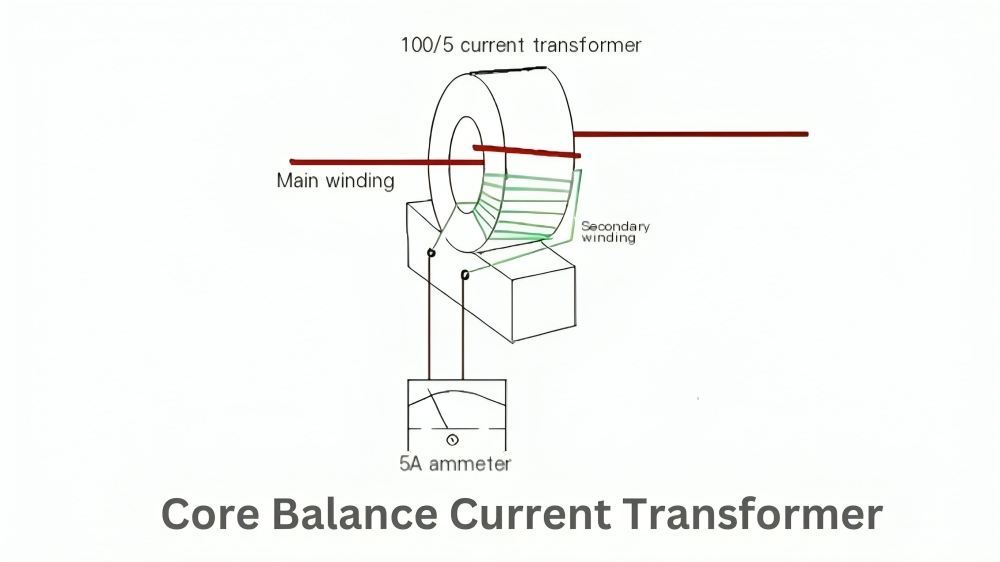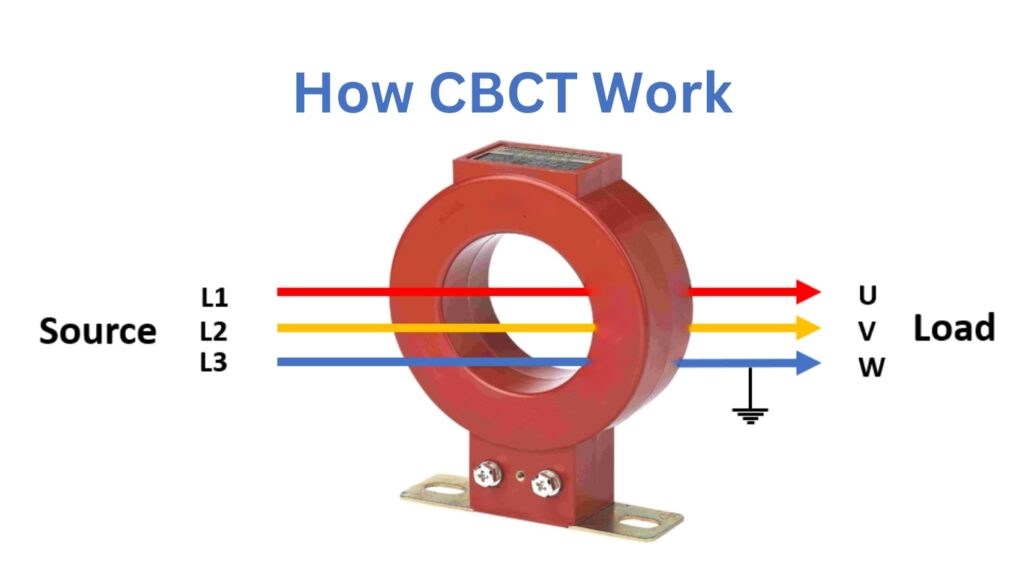In today’s high-tech environment, where technology changes every second, electrical safety is taken very seriously. Among the devices that are quite effective in protecting electrical systems is the Core Balance Current Transformer (CBCT). This article aims to give a comprehensive, SEO-friendly introduction to CBCTs, their working principles, significance, and prospective uses in contemporary electrical systems.
What do you understand by a Core Balance Current Transformer (CBCT)?
One type of a current transformer that is very effective in identifying circuit failures in electrical systems is known as the Core Balance Current Transformer (CBCT). Of extreme importance is its ability to detect leakage or residual current in a system, which is typically caused by defective insulation or earthing system breakdown. In this way, it plays an important role in preventing electrical risks by identifying any imbalance that could pose a danger to the electrical network.
They are also found in applications where the safety of the systems being protected from overcurrent requires that the residual current be kept under constant supervision, such as in industrial plants, offices, and homes.

How Does a Core Balance Current Transformer Work?
The working principle of a core balance current transformer is simple but very effective. There is a toroidal core within which all the current-carrying conductors including the phase and neutral lines are present. In normal circumstances, the currents in the phase and neutral conductors should add to zero. However, when an insulation medium around a conductor, such as an electric cable suffers damage or deterioration, a current imbalance occur which results to a residual current in hand.

This imbalance is detected by the CBCT and the differential current that results is executed as a tripping action on the circuit breaker or alarms out according to what the system is designed for. This direct action towards the differential current alternations has over time prevented the risks of electrical shocks, electrical fires and damage to equipment that may have electrical malfunctions.
Importance of CBCT in Electrical Safety
Electrical faults in the ground for example ground fault are a common occurrence in both industrial and residential settings. They carry great dangers like electrical fires, damage of equipment and personnel risk. And this is where CBCTs are very helpful. This continuous monitoring of the current flow is done by the transformer which then activates safety controls when a fault is detected.
Several reasons suggest the significance of the CBCTs in relation to electrical safety and these are as follows:
Protection against Electrical Fires:
A ground fault or any breach in insulation will cause excessive heat build-up which may eventually cause a fire. CBCTs are able to recognize the minutest current leak, thus, averting instances of fires.
Equipment Safety:
A large portion of the operating systems are responsible for running costly powered equipment. This includes breakdowns that could cause costly repairs or loss of business because of downtime. This equipment is further retained by CBCTs thanks to their capability to respond to such threats with immediate actions.
Human Safety:
Human life is endangered by electric shock under ground faults. Such faults can be detected by the CBCT making working environments and environments free from such hazards.
Meeting Safety Requirements:
Certain regions have legislation stipulating that electric installation systems must ensure enough CBCTs are in place in order to operate under safety codes such as the IEC or IEEE or the NEC.
Uses of Core Balance Current Transformers
CBCTs are used in diverse fields in which there is a need to detect and control current leakage, their uses include the following.
Industrial Plants:
In the case of large manufacturing plants, the complexity of power distribution is coupled by high tendency for faults. In such situations, CBCT is employed to shield motors, transformers and other delicate devices from ground faults.
Commercial Buildings:
Establishments like office complexes, shopping centers, and hotels need dependable power distribution. The role of a CBCT is to eliminate electrical hazards in these buildings by monitoring the current flow and locating imbalances.
Renewable Energy Systems:
Sufficient measures are taken to insulate sensitive electric circuits associated with solar or wind energy systems from faults. Evidently, CBCTs are used in such systems to protect against and monitor leakage currents to prevent damage.
Residential Installations:
In houses, electric CBCTs are useful in the avoidance of electric shocks as well as preventing ground faults which may cause fires. Most a movants of showers and heating systems are built into house holders circuit breakers.
Data Centers:
Data centers includes vital information communication technology facilities where even a minor electric fault may result excessive downtimes and loss of data. Then such situations call for CBCT’s diagnosis.
Medical Facilities:
Medical care relies on some specialized devices that need protection from losing power conditions. In such environments, power systems are critical, and the use of CBCTs bolsters the safety and reliability of such systems.
Types of Core Balance Current Transformers
Different types of core balance current transformers (CBCTs) may be manufactured for different applications. Some of the common types are as follows:

Window-type CBCT:
A window-type transformer consists of a toroidal core encasing all the conductors, and more common of the CBCT-T model. This type is excellent for residual current detection.
Split-core CBCT:
Such transformers are intended for the use of existing installation without the need to disconnect current carrying conductors. They can be easily opened and clamped around the cables, and then closed to make a complete toroidal core.
Low-sensitivity CBCT:
This type of is adapted to use under conditions of high ground fault current such as in industries.
High-sensitivity CBCT:
These types of equipment are meant to be used in applications where other than leakage currents are required to be detected, thus the equipment includes within the residual current sensing any small residual amounts.
Key Features of Core Balance Current Transformers
Contributing to the reliability of modern electrical grids, core balance current transformers have several capabilities and advantages:
High Sensitivity:
Another advantage is that even a small imbalance in current within the cables allows the CBCTs to detect the fault and break ensuring that the apparatus is protected.
Wide Frequency Range:
They perform well within wide frequency ranges which gets rid of limitations in their field of application.
Compactness:
CBS’s are generally wide and can be installed with ease. This makes them suitable both for new set ups and also where alterations have to be made to come up with new installations.
Functional:
CBS’s have been able to work under low and medium voltage applications. This allows the use of different environments.
Sturdy Structure:
CBS’s are built with the intention of withstanding extreme climatic conditions hence making them very reliable and durable over a long time even in industrial use.
Advantages of Employing Core Balance Current Transformers
The employment of Core Balance Current Transformers in electrical systems helps in improving, enhancing and saving a considerable amount of costs. Some of these advantages include.
Improved Electrical Safety:
CBT’s detects imbalance in current and acts instantly to prevent unwanted events like electrical fires and electric shock.
Reduced Production Delay:
CBT’s minimizes the outage time that is due electrical failures by detecting faults and isolating them, which guarantees an unbroken flow of any operations in industries and businesses.
Reduction in Cost:
Prevention of electrical faults from transforming to major problems assists in avoiding expensive repair or replacement of equipment.
Legislations Conformity:
Application of CBCT ensures that the companies are dependent on the universal safety regulations which is beneficial to avoid penalties and lawsuits.
Preventing Damage to Delicate Devices:
The core balance current transformer reduces the effects of the ground fault on delicate systems like computers, medical devices as well as communication devices.
Fitting Core Balance Current Transformers
The CBCT installation ought to be precision based to notice optimal performance. Generally, they are located on main conductors such that all the conductors (phase and neutral) go through the core. Any current which is present because of leakage or a fault and is allowed to flow, results in an imbalance and thus is detected by the CBCT.
Particular attention should be given to the amount of conductors which the CBCT monitors so that the core may be properly sized. It is also critical as it should be positioned so effectively so that any imbalances are detected as soon as they occur. Additionally, it should be arranged in such a way that action can be taken when a fault occurs. A protection device like a relay or circuit breaker is required for this.
Testing and Maintenance of Core Balance Current Transformers
As with other elements of the electrical system, a CBCT should be tested and maintained at all times under normal operating conditions. Normal tests involve determining the transformer’s sensitivity and subjecting it to a fault to determine whether or not the protective devices are activated. This testing is crucial in order to confirm that the CBCT will be operational in an actual fault situation.
Moreover, checking the installation from time to time helps to identify whether there is any physical loss in the transformer components or its attachments. This maintenance in itself plays a great role in extending the life of the CBCT and continues to make the electrical system safe.
Future of Core Balance Current Transformers
As the existing electrical technologies throughout the world keep improving with the advent of the smart grids and other renewable energy system works, it is anticipated that the integration of core balance current transformers will also be enhanced. Further developments may embrace integration of core balance current transformers systems into the IoT where they will be able to give instant alerts and diagnostics through other devices.
At the same time, since there is a growing concern for electrical safety in homes, businesses and industries in general, there will be more breakthroughs in the development of the core balance current transformer making it a perfect tool in detection of electrical faults.
In Summary
The Core Balance Current Transformer (CBCT) has remained a silent safe guardian in any installation subject to electrical activity within various fields of applications. It averts conditions which may lead to accidents such as electrical fires, destruction of other equipment, or even loss of human life and activities that imbalance the current. The popularity and adoption of CBCT systems within industries and businesses and residential housing developments further demonstrates their relevance in electrical installations today.
Organizations and individuals who invest in CBCTs will face enhancements in the safety of their electrical systems while being compliant, having reduced downtimes, and protecting their expensive assets. Also, as technology keeps on developing, it will be observed that CBCTs will become more important and more functional hence essential in the future of electrical safety.
Lastly, it is important to acknowledge that for a sustainable management or creation of any electrical system, it is essential to understand how CBCTs work, where they are applied and what benefits are offered to the users.
Visit our latest Blog about (Power Triangle: How to make Better Understand) Any question regarding to this article please contact us.
Frequently Asked Questions (FAQs) on Core Balance Current Transformer
Q1.What is a Core Balance Current Transformer (CBCT)?
A CBCT is an abbreviation of Core Balanced Current Transformer. It is a type of current transformer that detects earth faults by measuring the imbalance in phase currents of a system.
Q2.How does a Core Balance Current Transformer work?
A Core Balance Current Transformer (CBCT) monitors earth faults by detecting the unbalance of phase currents. The phase conductors are arranged in a way that all pass through a common magnetic core. At rest, these currents cancel one another resulting in a net current of zero, therefore no current flux is induced. An earth fault leads to some current leaking to the ground which triggers an imbalance. Such an imbalance gives rise to a net magnetic flux in the core with a resultant induced voltage in its secondary winding. The output is fed to protective relays which then detect and trip the circuit for further protection from damage and ensure safety.
Q3.Where is CBCT used?
CBCTs are earth fault detectors widely applied in power distribution modern technologies, in industrial machines, electrical panels and even in transformer protection systems.
Q4.What is the difference between CBCT and a regular current transformer?
The functionality and structure of a Core Balance Current Transformer (CBCT) differs from those of a regular current transformer (CT).
To begin, a CBCT mitigates an earth fault circuit by watching for leakage or residual current. The way it works is by having all phase conductors and the neutral wire included in a single toroidal core. In normal conditions, the sum of phase currents should be zero. However, during a fault, some form of imbalance occurs which leads to a secondary current being generated, therefore triggering the protection mechanism.
In contrast, a regular CT is purposed for protection and measurement of direct and alternating current (i.e. it steps down high currents to a lower, measurable level). A regular CT is set on individual conductors of a phase in motors, transformers, power lines to monitor the flow of current and provide input signals for meters or relays.
The key consideration here is that CBCTs watch for imbalance in currents (earth faults). A regular CT does the direct opposite; they monitor ammeter phase currents for protection and measurement.
Q5.Why is CBCT important in electrical systems?
CBCT makes it possible to eliminate hazards in electrical installations by detecting the insignificant leakage currents that would have resulted in fires, equipment damage or even electrical shocks.
Q6.How do you install a Core Balance Current Transformer?
The CBCT core is where the three-phase conductors (L1, L2, L3) pass through. This ensures that they are properly positioned in order to get accurate fault detection. The neutral conductor is almost always left out.
Q7.What types of faults can a CBCT detect?
CBCT outputs are used for earth fault or ground leakage current detecting which indicate insulation or grounding failure.
Q8.What are the key specifications to consider when selecting a CBCT?
An important note regarding supply current: primary current rating, core influence, burden (VA), accuracy class and voltage level are some of the systems that define its figure.
Q9.Can CBCT be used for both low-voltage and high-voltage applications?
Different forms and insulation designs permit CBCT to operate with low voltage networks and high voltage systems.
Q10.What is the output of a CBCT?
You can confirm correct functionality of a CBCT through primary or secondary injection testing, or by simulating a leakage current situation.
Q11.How do you test a Core Balance Current Transformer?
A monitoring relay serves as a protective relay. It gets some current proportional to detected leakage, which is nominally delivered through the CBCT.
Q12.What causes false tripping in CBCT systems?
Incorrect wiring or placement of load currents and powers, as well as corrosion of the shield and noise fields, can lead to false tripping.
Q13.How can you prevent CBCT malfunctions?
Regular testing of the shielding and verification of no residual magnetism in the core will help to prevent malfunction.
Q14.What should be done if a CBCT does not detect faults properly?
Check for faulty wiring through the CBCT core, mispositioned conductors, or mispositioned relay settings.
Q15.How often should a CBCT be inspected or maintained?
Annual inspection is recommended for CBCTs, and functional testing is done at intervals.
